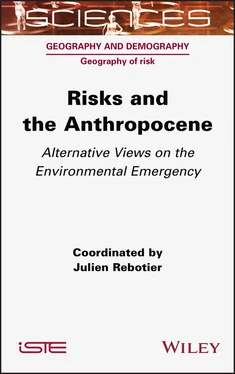The Anthropocene will be discussed in this introduction as a singular moment that seems to be taking shape, but it is indeed risk research, in its diversity and from the social sciences, that is at the heart of this book. In many respects, the Anthropocene moment remobilizes old questions about risk: relations between societies and environments, solidarity and inequalities, the hegemony of the naturalistic approach, the political nature of environmental issues, etc. Interrogating the knowledge produced by the social sciences on the notion of the Anthropocene thus makes it possible to point out fundamental debates, often hidden behind simple reformulations.
I.2. Defining the Anthropocene: ways of seeing, ways of thinking
I.2.1. A global framing by the Earth sciences
In the early 2000s, geochemist Paul Crutzen helped popularize the notion of the Anthropocene (Crutzen and Stoermer 2000). The rapid introduction of the notion into the global science arena was partly orchestrated from the International Geosphere-Biosphere Programme – an international initiative led by the International Council for Science (ICSU) – where Crutzen served as vice-president. The IGBP aims to coordinate research at global and regional scales on the earth system, on the biogeochemical interactions that constitute it, and on the interactions maintained with societies. The IGBP is part of the trend toward the globalization of environmental issues, toward the consolidation of a planetary, atmospheric and climatic framework, then more broadly biogeochemical, and toward the train of major scientific initiatives driven by international governance – through the United Nations system. Thus, the creation of the IGBP in 1987 followed that of the World Climate Research Programme in 1979. Concerns about climate extend to global change in general in order to measure human impacts on the environment, from what would become the Earth sciences, which are well suited to address changes in the earth system. In 1988, the Intergovernmental Panel on Climate Change was formed, laying the foundations for a type of governance of climate and environmental issues already analyzed by the social sciences (Dahan and Aykut 2015).
The Anthropocene postulates that humanity’s influence on the geosphere and biosphere is such that it can define a specific geological epoch that would bear its name (Crutzen 2002). The recognition of human influence on the Earth is not new (Marsh 1865; Crutzen 2007) and, through a form of human ecology, it even constitutes one of the foundations of geographical questioning (Robic 2006, pp. 28–29). But the recent success of the notion can be understood in two ways. It is due to the intensity and unprecedented nature of interactions between societies and environments (Gemenne et al. 2019), as well as to the conditions in which scientific knowledge is produced, to the structuring of a globalized intellectual climate that weighs heavily on the practice of research (Castree et al . 2014), and to the place of the environmental question within globalized societies (Smith 2010). These two bundles of elements, namely the physical reality of unprecedented consequences of human–environment interactions, on the one hand, and the social configurations that accompany them, on the other hand, constitute the Anthropocene moment. The latter is of interest to the reflections gathered in this work on risk assessment and risk management.
I.2.2. From controversies on the boundary…
I.2.2.1. The steam engine, the Industrial Revolution and the Great Acceleration
Proposing the Anthropocene as a new geological epoch requires compliance with the rules of the International Commission on Stratigraphy, the body within the International Union of Geological Sciences that oversees the standardization of a geological time scale. Designating the boundaries of a geological epoch requires two conditions. It is necessary to be able to locate the traces of a global event left in stratigraphic materials (rocks, ice, sediments) and to associate them with other stratigraphic markers indicating changes in the whole earth system. Duly localized traces constitute a “golden spike” 4.
For Crutzen and Stroemer (2000), it is the increase in the amount of CO 2found in the atmosphere (visible in ice cores) that marks the beginning of the Anthropocene at the end of the 18th century. This period corresponds to the beginnings of the industrial revolution. The authors link it to the introduction of the steam engine patented by James Watts in 1784. Thanks to the multiplication of the data collected, a period of “great acceleration” after the Second World War has been identified more precisely (Steffen et al. 2007). The malady was diagnosed, tracing the horizon of a techno-scientific and moral research agenda supposed to respond to the major dysfunctions that this evolution has partly caused:
A daunting task lies ahead for scientists and engineers to guide society towards environmentally sustainable management during the era of the Anthropocene. This will require appropriate human behaviour at all scales, and may well involve internationally accepted, large-scale geo-engineering projects, for instance to “optimize” climate. (Crutzen 2002, p. 23)
Despite the confidence displayed, evidence is lacking to close the stratigraphic debate on the Anthropocene. Above all, underlying ways of seeing the world clash across such categorization, underscoring the interest of axiological controversies in addition to metrological ones:
Care is needed to ensure that the dominant culture of today’s scientists does not subconsciously influence the assessment of stratigraphic evidence. (Lewis and Maslin 2015, p. 173)
I.2.2.2. A range of possible hypotheses
Geological time is marked by changes in the state of the Earth. Between the end of the Pleistocene (11,700 years ago) and the 1960s, several events are strong candidates as anthropogenic signatures of geologic epoch change. Lewis and Maslin (2015) explore several hypotheses and select two.
The great fires associated with the Pleistocene mass extinctions are discarded, their traces not being explicitly global enough. The stratigraphic evidence of the beginnings of agriculture and the upheavals of the Neolithic are not considered sufficiently synchronous. The process of industrialization and then the industrial revolution bequeath diverse and temporally dispersed markers. On the other hand, 1610 and 1964 are favored by authors as potential starting points of the Anthropocene.
For 1610, the consequences of the discovery of the Americas by the Europeans at the very end of the 15th century led to the global dissemination of pollens of many species and to the massive sequestration of carbon. In a few decades, the genocidal impact of the bacteriological shock on the Amerindian populations led to the death of 90% of the indigenous population and the rewilding of 50 million hectares of forest, wooded savannahs and grasslands, for lack of manpower to work them. Considerable amounts of CO 2were captured, removed from the atmosphere, as indicated by the ice cores that report the date of 1610 (Lewis and Maslin 2015, p. 175). For 1964, in the context of the “Great Acceleration,” it is a spike in the concentration of 14C (a radioactive isotope of carbon) in ice and trees that wins favor with Steffen et al. (2015). The 14C spike evidenced in the stratigraphic material was linked to a frequency of nuclear explosions on the Earth’s surface unmatched by any other time period.
Each hypothesis reflects an image of societies and their relationship to the environment. The date of 1610 emphasizes the domination and exploitation of resources. The 1964 date points to the concord of an international governance capable of banishing – or at least reducing significantly – the use of nuclear weapons. The fact remains that there is no consensus on the stratigraphic evidence and, above all, that it is only a matter of conforming to the requirements of geology. As such, the axiological controversies surrounding the Anthropocene carry more meaning – and are of greater interest – to the social sciences than the debates on the stratigraphic classification that presides over its identification from the Earth sciences.
Читать дальше












